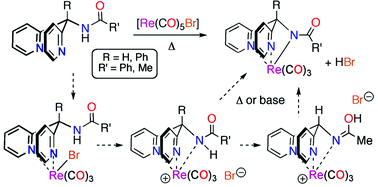The complexes formed from the reaction of N-acylated tris-(pyridin-2-yl)methylamine (LH) with [Re(CO)5Br] depend on the structure of the ligand and the reaction conditions. Thus, while N-[1,1,1-tris-(pyridin-2-yl)methyl]acetamide coordinates through the three pyridine nitrogens to give a stable cationic complex [LHRe(CO)3Br], the analogous N-benzoyl ligand reacts under similar conditions to give a neutral complex [LRe(CO)3] with coordination through two pyridine nitrogens and a deprotonated amide. To try to explain these different outcomes, the reactions of some structurally related N-acylated [1,1-bis(pyridin-2-yl)]methylamines (L′H) with [Re(CO)5Br] have been studied and the reaction pathways identified. These studies indicate that a neutral complex [L′HRe(CO)3Br] is initially formed in which the amide portion of the ligand is uncoordinated, but that this complex under appropriate conditions then rearranges to give a cationic complex [L′HRe(CO)3]Br in which the coordinated amide nitrogen either remains protonated or is present in its imidic acid tautomeric form. Elimination of HBr from these complexes either thermally or in the presence of base then gives stable neutral complexes [L′Re(CO)3]. The impact of the N-acyl group and any substituent at the apex of the tripodal ligands (L′′H) on the relative stabilities of intermediate complexes on the reaction pathway helps provide an explanation for the observed difference in behaviour of the N-acylated tris(pyridin-2-yl)methylamines (LH).

You have access to this article
 Please wait while we load your content...
Something went wrong. Try again?
Please wait while we load your content...
Something went wrong. Try again?


 Please wait while we load your content...
Please wait while we load your content...